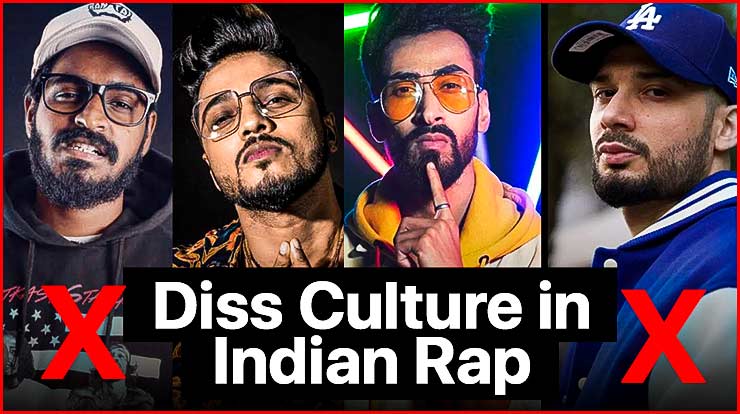A diss between two rappers has gained immense popularity amongst audiences these days, so let’s unravel the history of diss culture in Indian rap.
A Brief Overview of Diss Culture in Rap
Diss culture, also known as the tradition of creating diss tracks or engaging in rap battles, has been a prominent part of the global hip hop scene for decades.
In India, this culture has gained traction with the rise of talented Indian hip hop artists, such as Raftaar, Emiway, and KR$NA. Diss tracks often involve artists throwing lyrical jabs at each other, showcasing their skills while addressing real or perceived issues within the rap community.
Raftaar vs. Emiway: A Heated Rivalry

- Inception of the Feud: Raftaar and Emiway feud began when Raftaar made a comment about Emiway’s financial status in an interview, which Emiway took offense to.
- Escalation through Diss Tracks: The rivalry escalated with both artists releasing diss tracks targeting each other, including Emiway’s “Samajh Mein Aaya Kya” and Raftaar’s “Sheikh Chilli.”
- Impact on the Rap Scene: Their feud grabbed the attention of fans and media, fueling discussions and debates about the artists’ skills and the state of Indian hip hop.
KR$NA vs. Emiway: A Battle of Lyrical Mastery

Origins of the Dispute: Emiway released a song Freeverse Feast and claimed himself to be the only rapper representing India across the globe. Trading Diss Tracks: Both artists released multiple diss tracks aimed at each other, such as KR$NA’s “I guess” and Emiway’s “Machayenge 4.”
The intense battle between KR$NA and Emiway generated a buzz in the Indian hip hop community, drawing attention to the diss culture and the skill of Indian rappers. Many found it to be overboard with the extended use of abusive remarks and dragging personal things into the beef. More and more, the two rappers have still not settled the feud, and we wonder when they will.
The Pros and Cons of Diss Culture in Indian Rap
- Creative Expression: Diss tracks can showcase the lyrical prowess and creativity of Indian hip hop artists, pushing them to develop innovative rhymes and wordplay.
- Exposure and Popularity: High-profile feuds can generate significant buzz for the artists involved, increasing their popularity and expanding their fan base.
- Negativity and Misunderstandings: Diss culture can also lead to negative perceptions and misunderstandings within the rap community, potentially damaging relationships between artists.
Chillme and the Role of Diss Culture

- Promoting Talented Indian Hip Hop Artists: Chillme supports and promotes talented Indian hip hop artists, acknowledging the role of diss culture in the growth and evolution of the Indian rap scene.
- Providing a Platform for Creativity: Chillme, in collaboration with the Baggy Movement, aims to encourage creative expression through various means, including diss tracks and rap battles, as long as it remains respectful and constructive.
The Future of Diss Culture in Indian Rap
- Evolving Narratives: Diss culture in Indian rap will continue to evolve, with artists refining their lyrical techniques and addressing different topics in their diss tracks.
- New Rivalries and Collaborations: As the Indian hip hop scene grows, new rivalries and collaborations will emerge, further fueling the development of diss culture and its impact on the rap community.
The Influence of Global Diss Culture on Indian Hip Hop
- Drawing Inspiration from International Rivalries: Indian hip hop artists have been inspired by the diss culture of global rap icons, such as the notorious feuds between Tupac Shakur and The Notorious B.I.G. or Nas and Jay-Z.
- Adapting to the Indian Context: While borrowing elements from international diss culture, Indian rappers have adapted their approach to reflect the unique sensibilities and experiences of their local audience, creating a distinct diss culture within the Indian rap scene.
Diss Culture as a Catalyst for Change in Indian Hip Hop
- Pushing Boundaries: Diss culture has played a vital role in pushing the boundaries of Indian rap, challenging artists to elevate their lyrical skills and embrace new styles and themes.
- Encouraging Diversity and Inclusivity: As diss culture continues to gain momentum in India, it has the potential to foster greater diversity and inclusivity within the rap community, promoting collaboration and dialogue among artists from different backgrounds and styles.
The Ethical Considerations of Diss Culture
- Striking a Balance: While diss culture can inspire creativity and competition, it is essential for artists to strike a balance between expressing their opinions and maintaining respect for their fellow artists.
- Avoiding Harmful Consequences: As diss tracks often involve personal attacks, it is crucial for artists to be mindful of the potential harm that may result from their words, both to their fellow artists and to the wider community.
Strategies for Navigating Diss Culture Responsibly
- Focusing on Artistic Expression: Artists should prioritize showcasing their skills and creativity in their diss tracks, rather than resorting to personal attacks or derogatory language.
- Embracing Constructive Criticism: Engaging in diss culture can be an opportunity for artists to learn from one another and grow, as long as they approach it with an open mind and a willingness to accept constructive criticism.
Conclusion: Diss Culture as a Driving Force in Indian Rap
Diss culture in Indian rap has become a powerful force, shaping the careers and artistic growth of top artists in India like Raftaar, Emiway, and KR$NA. With Chillme’s support and the continuous evolution of Indian hip hop, diss culture will remain a significant part of the Indian rap landscape, fostering creativity, friendly competition, and a sense of unity among artists and fans.
Frequently Asked Questions
A. Diss culture in rap refers to the tradition of creating diss tracks or engaging in rap battles, where artists throw lyrical jabs at each other to showcase their skills and address issues within the rap community.
A. Raftaar vs. Emiway began after a comment about Emiway’s financial status, while KR$NA vs. Emiway started when the later claimed to be the only rapper representing India overseas.
A. Chillme promotes talented Indian hip hop artists and encourages creative expression, including diss tracks and rap battles, as long as it remains respectful and constructive.
A. Benefits of diss culture include showcasing lyrical prowess, increasing exposure and popularity, while drawbacks may involve negativity and misunderstandings within the rap community.
